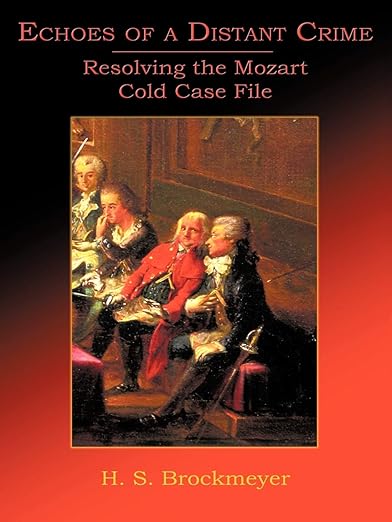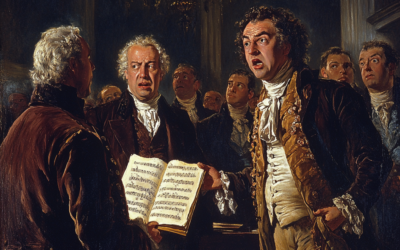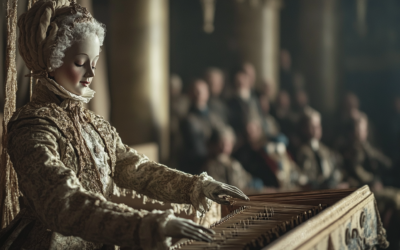Unveiling Hidden Plots
The True Caregiver
Article written by H. S. Brockmeyer
Wolfgang Amadeus Mozart’s final days have always been shrouded in mystery, both due to the circumstances of his death and the ambiguity surrounding who genuinely cared for him as his life ebbed away.
The True Caregiver by H. S. Brockmeyer invites us to reassess whether it was Mozart’s wife, Constanze, or her sister, Sophie Haibl, who provided true devotion during those distressing moments.
By using letters, diaries, and firsthand accounts, Brockmeyer examines emotional dynamics, medical practices, and religious tensions, encouraging readers to question the historical narratives we have long taken for granted.
“Memory, myth, and selective storytelling have crafted the Mozart we think we know, but the truth is far more complicated.”
Echoes of a Distant Crime: Resolving the Mozart Cold Case File
Unraveling the Mystery Behind the Final Moments and Support System of Wolfgang Amadeus Mozart.
Wolfgang Amadeus Mozart’s final days have always been shrouded in mystery, not only because of the enigmatic circumstances surrounding his death but also due to the ambiguity about who truly cared for him as his life ebbed away. In The True Caregiver by H. S. Brockmeyer, we are invited to reassess long-held beliefs about the key figures by Mozart’s side during those distressing last moments.
One topic that has never been debated—or even noticed until now—is the role of Sophie Haibl in Mozart’s final days. Brockmeyer is the first to uncover the significance of the plaque over their apartment in Mozartplatz and the gravestone in the Kommunalfriedhof in Salzburg, which honor Sophie as the ‘true caregiver’ in Mozart’s last hours. She invites us to question why Mozart died in Sophie’s arms, not Constanze’s, and explores Sophie’s often-overlooked impact as a devoted caretaker.
Using letters, diaries, and testimonies from contemporaries, the author paints a vivid picture of Mozart’s final days. She examines Sophie’s account of Mozart’s death, including the controversial tale of the physician, Dr. Closset, who preferred attending the theater over attending the stricken composer. The narrative delves into the medical practices of the time, such as Mozart’s infamous bloodletting treatment, and questions the effectiveness—and perhaps the negligence—of these methods.
Brockmeyer expands on the emotional and social dynamics at play. She explores how Sophie’s story has been elevated over the years, potentially to shield Constanze from criticism or to create a more compelling narrative of sisterly devotion. Sophie’s account, though filled with intimate details, is analyzed for possible exaggerations or errors, as she recounted them many years later. Brockmeyer critically assesses whether Sophie’s memory, shaped by time and perhaps her desire to appear virtuous, stands up to scrutiny against the surviving historical evidence.
Constanze emerges as a complex and often misunderstood figure. In previous accounts, she has been harshly judged and accused of selfishness or neglect, yet Brockmeyer urges a reconsideration. She argues that despite the criticisms, Constanze played a crucial role in preserving Mozart’s legacy. After his death, she worked tirelessly to promote his music and secure his place in history. Brockmeyer emphasizes that this dedication, often overlooked, shaped our modern understanding of Mozart’s genius.
The article also touches on broader cultural and religious tensions. Brockmeyer doesn’t shy away from discussing the strained relationship between Mozart’s Masonic beliefs and the Catholic Church. One of the most poignant details is the refusal of a priest to administer the last rites. This refusal deepens the mystery and adds a layer of religious and philosophical conflict that colored the composer’s final days. The author also highlights how Mozart’s ties to the Freemasons may have influenced both his life and the circumstances surrounding his death, complicating our understanding of those around him.
In the end, Brockmeyer acknowledges that some details about Mozart’s death may forever remain a mystery. Still, she encourages readers to think critically about who truly cared for Mozart and to question the accounts we often take for granted. This nuanced approach reveals the complexities of human relationships and the ways in which history is constructed, layer by layer, through memory, myth, and selective storytelling.
![Sophia_Weber_Haibl Portrait of Maria Sophie Weber (1763[1]–1846), singer, the younger sister of Wolfgang Amadeus Mozart's wife, Constanze](https://www.mozartrazom.com/wp-content/uploads/2024/11/Sophia_Weber_Haibl.jpg)
Portrait of Maria Sophie Weber (1763–1846)
To uncover more about the compelling narrative surrounding Mozart’s final days and the complex roles played by those closest to him, you can download the complete article by H. S. Brockmeyer at the link below.
Download the full document (pdf)
You May Also Like
When the Myth Collapsed
Vienna exposed the myth: La Finta semplice was riddled with errors, and Wolfgang’s supposed opera genius was nothing more than Leopold’s fabrication. With their reputation in ruins, father and son turned to Italy, hoping to rewrite history.
The London Notebook and the Vienna Disaster
Far from the myth of a flawless young genius, Mozart’s London Notebook reveals musical struggles and guided exercises, while the Vienna opera disaster proved that his father played a far greater role in his compositions than legend would have us believe.
Versailles, Vanity, and the Pursuit of Prestige
Leopold Mozart’s letters transformed his son’s European tour into a carefully staged fantasy—filled with exaggerated encounters, fabricated royal admiration, and a relentless pursuit of social prestige. But how much of it was real?
The Fabricated Childhood of Mozart
The legend of young Mozart’s divine genius crumbles under scrutiny, revealing a childhood dictated by Leopold’s ambition, carefully constructed myths, and a relentless pursuit of fame at the expense of genuine artistic education.
The Man Behind the Myth
Leopold Mozart’s legacy has been shaped by myths and hagiographies, but his letters reveal a man more concerned with financial gain and self-promotion than artistic integrity. Was he truly a devoted father, or simply an opportunist?
Constanze vs. The Catholic Church
For over two centuries, scholars have debated the circumstances surrounding Mozart’s burial. Constanze Mozart’s supposed inability to mark his grave, the confrontation with the Catholic Church over funeral masses, and the baffling disappearance of Mozart’s body all contribute to a mystery stranger than fiction. Did a powerful group keep her silent? And what really happened to Mozart’s remains?







